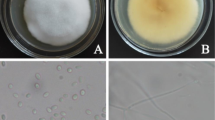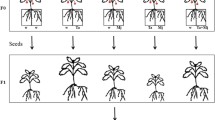Abstract
The endophytic fungus Fusarium oxysporum strain Fo162 and the endophytic bacterium Rhizobium etli strain G12 have been shown to enhance plant resistance toward the root-knot nematode Meloidogyne incognita. The individual inoculation of tomato seedlings with these antagonists lead to significant reductions in the number of juveniles that penetrated the root and ultimately the number of galls and egg-masses produced. The present study determined the influence of Fo162 and G12 root colonization on juvenile development inside the root system over time after a synchronized nematode infection. The results showed that 14 and 21 days after nematode inoculation, the development into the third-stage juvenile as well as into the adult-stage was significantly lower in endophyte-treated plants when compared to the untreated control, respectively. In addition, Fo162 and G12 treatment led to a significant reduction in the number of eggs per female 35 days after nematode inoculation. The results demonstrated that both Fo162 and G12 not only reduce M. incognita root penetration, but also reduce their development and reproduction.



Similar content being viewed by others
References
Abad P, Castagnone-Sereno P, Rosso MN, de Almeira Engler J, Favery B (2009) Invasion, feeding and development. In: Perry RN, Moens M, Starr JL (eds) Root-knot nemadodes. CABI Publishing, Wallingford, UK, pp 163–181
Becker JO, Tavaleta-Mejia E, Colbert SF, Schroth MN, Weinhold AR, Hancock JG, van Gundy SD (1988) Effects of rhizobacteria on root-knot nematodes and gall formation. Phytopathology 78:1466–1469
Bird AF (1962) The inducement of giant cells by Meloidogyne javanica. Nematologica 8:1–10
Cabrera JA, Kurtz A, Sikora RA, Schouten A (2010) Isolation and characterization of fenamiphos degrading bacteria. Biodegradation 21:1017–1027
Caillaud MC, Dubreuil G, Quentin M, Perfus-Barbeoch L, Lecomte P, de Almeida Engler J, Abad P, Rosso MN, Favery B (2008) Root-knot nematodes manipulate plant cell functions during a compatible interaction. J Plant Physiol 165:104–113
Chen LQ, Hou BH, Lalonde S, Takanaga H, Hartung ML, Qu XQ, Guo W, Kim JG, Uderwood W, Chaudhuri B, Chermak D, Antony G, White FF, Somerville SC, Mudgett M, Frommer WB (2010) Sugar transporters for intracellular exchange and nutrition of pathogens. Nature 468:527–532
Coyne DL, Nicol JM, Claudius-Cole B (2007) Practical plant nematology: a field and laboratory guide. SP-IPM Secretariat, International Institute of Tropical Agriculture (IITA), Cotonou, Benin, p 82
Dababat AEA, Sikora RA (2007a) Induced resistance by the mutualistic endophyte, Fusarium oxysporum strain 162, toward Meloidogyne incognita on tomato. Biocontrol Sci Technol 17:969–975
Dababat AEA, Sikora RA (2007b) Importance of application time and inoculum density of Fusarium oxysporum 162 for biological control of Meloidogyne incognita on tomato. Nematropica 37:267–275
El-Fattah A, Dababat AA, Sikora RA (2007) Influence of the mutualistic endophyte Fusarium oxysporum 162 on Meloidogyne incognita attraction and invasion. Nematology 9:771–776
Endo YB, Wergin WP (1973) Ultrastructural investigation of clover roots during early stages of infection by the root-knot nematode, Meloidogyne incognita. Protoplasma 78:365–379
Ferris JM (1985) Crop loss prediction and modeling for management decisions. In: Zuckerman BM, Mai WF, Harrison MB (eds) Plant nematology-laboratory manual. The University of Massachusetts Agricultural Experiment Station, Amherst, USA, pp 27–33
Hallmann J, Sikora RA (1994) Influence of F. oxysporum, a mutualistic fungal endophyte, on M. incognita of tomato. J Plant Dis Prot 101:475–481
Hallmann J, Quadt-Hallmann A, Miller WG, Sikora RA, Lindow SE (2001) Endophytic colonization of plants by the biocontrol agent Rhizobium etli G12 in relation to Meloidogyne incognita infection. Phytopathology 91:415–422
Hallmann J, Davies KG, Richard RA (2009) Biological control using microbial pathogens, endophytes and antagonists. In: Perry RN, Moens M, Starr JL (eds) Root-knot nemadodes. CABI Publishing, Wallingford, UK, pp 380–411
Hasky-Günther K, Sikora RA (1995) Induced resistance: a mechanism induced systemically throughout the root system by rhizosphere bacteria towards the potato cyst nematode Globodera pallida. Nematologica 41:306 [Abstract]
Hasky-Günther K, Hoffmann-Hergarten S, Sikora RA (1998) Resistance against the potato cyst nematode Globodera pallida systemically induced by the rhizobacteria Agrobacterium radiobacter (G12) and Bacillus sphaericus (B43). Fundam Appl Nematol 21:511–517
Hooper DJ, Llaman J, Subbotin SA (2005) Methods for extraction, processing and detection of plant and soil nematodes. In: Luc M, Sikora RA, Brige J (eds) Plant parasitic nematodes in subtropical and tropical agriculture, 2nd edn. CABI Publishing, Wallingford, UK, pp 53–86
Hussey RA, Barker KP (1973) A comparison of methods for collecting inocula for Meloidogyne ssp., including a new technique. Plant Dis Rep 57:1025–1028
Kerry BR (1990) An assessment of progress towards microbial control of plant parasitic nematodes. J Nematol 22:621–631
Kiewnick S, Sikora RA (2006) Biological control of the root-knot nematode Meloidogyne incognita by Paecilomyces lilacinus strain 251. Biol Control 38:179–187
King EO, Warth M, Raney ED (1954) Two simple media for the demonstration of procyanin and fluorescin. J Lab Clin Med 44:301–307
Leeman M, Pelt JA, van Ouden FM, den Heinsbroek M, Bakker PAHM, Schippers B (1995) Induction of systemic resistance by Pseudomonas fluorescens in radish cultivars differing in susceptibility to Fusarium wilt, using a novel bioassay. Eur J Plant Pathol 101:655–664
Manzanilla-López RH, Evans K, Bridge J (2004) Plant diseases cased by nematodes. In: Chen ZX, Chen SY, Dickson DW (eds) Nematology, nematode management and utilization. vol 2. CABI Publishing, Wallingford, UK, pp. 637–703
Martinuz A, Schouten A, Sikora RA (2012) Systemically induced resistance and microbial competitive exclusion: implications on biological control. Phytopathology 102:260–266
Menjivar RD, Hagemann MH, Kranz J, Cabrera JA, Dababat AA, Sikora RA (2011) Biological control of Meloidogyne incognita on cucurbitaceous crops by the non-pathogenic endophytic fungus Fusarium oxysporum strain 162. Int J Pest Manag 57:249–253
Menjivar RD, Cabrera JA, Kranz J, Sikora RA (2012) Induction of metabolite organic compounds by mutualistic endophytic fungi to reduce the greenhouse whitefly Trialeurodes vaporariorum Westwood infection on tomato. Plant Soil 352:233–241
Moens M, Perry RN, Starr JL (2009) Meloidogyne species: a diverse group of novel and important plant parasites. In: Perry RN, Moens M, Starr JL (eds) Root-knot nemadodes. CABI Publishing, Wallingford, UK, pp 1–17
Noling JW, Becker JO (1994) The challenge of research and extension to define and implement alternatives to methyl bromide. Suppl J Nematol 26:573–586
Oka Y, Cohen Y, Spiegel Y (1999) Local and systemic induced resistance to the root-knot nematode in tomato by dl-b-amino-n-butyric acid. Phytopathology 89:1138–1143
Ploeg AT, Phillips MS (2001) Damage to melon (Cucumis melo L.) cv. Durango by Meloidogyne incognita in Southern California. Nematology 3:151–157
Proite K, Carneiro R, Falcao R, Gomes A, Leal-Bertioli S, Guimaraes P, Bertioli D (2008) Post-infection development and histopathology of Meloidogyne arenaria race 1 on Arachis spp. Plant Pathol 57:974–980
Racke J, Sikora RA (1992) Isolation, formulation and antagonistic activity of rhizobacteria towards the potato cyst nematode Globodera Pallida. Soil Biol Biochem 24:521–526
Reimann S, Hauschild R, Hildebrandt U, Sikora RA (2008) Interrelationship between Rhizobium etli G12 and Glomus intraradices and multitrophic effects in the biological control of the root-knot nematode Meloidogyne incognita on tomato. J Plant Dis Prot 115:108–113
Reitz M, Rudolph K, Schroeder I, Hoffmann-Hergarten S, Hallmann J, Sikora RA (2000) Lipopolysaccharides of Rhizobium etli strain G12 act in potato roots as an inducing agent of systemic resistance to infection by the cyst nematode Globodera pallida. Appl Environ Microbiol 66:3515–3518
Sainhorst JW (1995) The effect of delay of attack of oats by Heterodera avenae on the relation between initial nematode density and plant growth, plant weight, water consumption and dry matter content. Nematologica 41:487–504
Schäfer K, Silva Fabry C, Sikora RA, Hauschild R (2006) Molecular investigations of rhizobacteria-induced systemic resistance toward the root-knot nematode Meloidogyne incognita in tomato. Multitrophic interactions in soil. IOBC/WPRS Bull 29:135–140
Selim M (2010) Biological, chemical and molecular studies on the systemic induced resistance in tomato against Meloidogyne incognita caused by the endophytic Fusarium oxysporum, Fo162. Ph.D. Dissertation. University of Bonn, Bonn, Germany
Sharon E, Bar-Eyal M, Chet I, Herrera-Estrella A, Kleifeld O, Spiegel Y (2001) Biological control of the root-knot nematode Meloidogyne javanica by Trichoderma harzianum. Phytopathology 91:687–693
Siddiqui IA, Shaukat SS (2003) Endophytic bacteria: prospects and opportunities for the biological control of plant-parasitic nematodes. Nematol Mediterr 31:111–120
Sikora RA, Fernandez E (2005) Nematode parasites of vegetables. In: Luc M, Sikora RA, Bridge J (eds) Plant parasitic nematodes in subtropical and tropical agriculture. CABI Publishing, Wallingford, UK, pp 319–392
Sikora RA, Schaefer K, Dababat AA (2007) Modes of action associated with microbially induced in planta suppression of plant-parasitic nematodes. Australas Plant Pathol 36:124–134
Sikora RA, Pocasangre L, zum Felde A, Niere B, Vu TT, Dababat AA (2008) Mutualistic endophytic fungi and in planta suppressiveness to plant parasitic nematodes. Biol Control 46:15–23
Starr JL (1993) Recovery and longevity of egg masses of Meloidogyne incognita during stimulated winter survival. J Nematol 25:244–248
Sturz AV, Christie BR, Matheson BG, Arsenault WJ, Buchanan NA (1999) Endophytic bacterial communities in the periderm of potato tubers and their potential to improve resistance to soil-borne plant pathogens. Plant Pathol 48:360–369
van Loon LC, van Bakker PAHM, Pieterse CMJ (1998) Systemic resistance induced by rhizosphere bacteria. Annu Rev Phytopathol 36:453–483
Vu TT, Hauschild R, Sikora RA (2006) Fusarium oxysporum endophytes induced systemic resistance against Radopholus similis on banana. Nematology 8:847–852
Williamson VM, Hussey RS (1996) Nematode pathogenesis and resistance in plants. Plant Cell 8:1735–1745
Acknowledgments
We thank the German Academic Exchange Service (DAAD) for funding this research through a Ph.D. Scholarship. This research was part of a Ph.D. project to study the inter-relationships between mutualistic endophytic microorganisms, root-knot nematodes and sap-sucking insects.
Author information
Authors and Affiliations
Corresponding author
Additional information
Handling Editor: Ralf Ehlers
Rights and permissions
About this article
Cite this article
Martinuz, A., Schouten, A. & Sikora, R.A. Post-infection development of Meloidogyne incognita on tomato treated with the endophytes Fusarium oxysporum strain Fo162 and Rhizobium etli strain G12. BioControl 58, 95–104 (2013). https://doi.org/10.1007/s10526-012-9471-1
Received:
Accepted:
Published:
Issue Date:
DOI: https://doi.org/10.1007/s10526-012-9471-1




